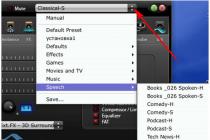Any personal computer consists of certain components that work together to allow the user to perform certain actions. However, many do not know why a computer needs RAM, a video card, a processor, a motherboard, a power supply, a hard drive, etc. Let's try to figure out what these elements are and what their role is in a modern PC device.
CPU
The heart of any computer is the processor, which can also be called a microprocessor. Such a component is a microcircuit, the main task of which is the processing of information received from input-output devices and RAM. Even to calculate two numbers, you need to call a specific processor command. During the entire time the computer is running, this element performs computational operations. In modern PCs, processors are even used in video adapters (video cards), which allows you to remove most of the load from the central processor.
Some personal computers have video cards with very powerful Components that are able to instantly perform complex graphics calculations when starting games. Of course, it is impossible for an inexperienced person to fully understand why a processor is needed in a computer, since there are extremely many subtleties of its work. The main thing is to understand the essence. It also comes down to calculations and processing of data received from peripheral devices. In other words, even moving the mouse is an operation processed by the processor, the result of which the user sees as the movement of the cursor across the screen.
Modern elements have several nuclei. These are separate processors operating in parallel based on the same circuit. Such a division of the chip into cores makes it possible to almost double the efficiency and speed of information processing, which entails a high speed of the system as a whole. There are four- and eight-core processors. However, the number of such elements does not always mean an increase in the efficiency of the device.
So why do we need cores in a computer? First of all, they are necessary to increase the speed of information processing, and secondly, to save energy consumption. Laptops that use mobile processors often use quad-core units, where two cores are high performance and the other two are energy efficient. The latter start to work when the processor does not need to process a large amount of data. However, when the amount of information and the complexity of tasks to process increase, high-performance cores are activated. The power rises sharply, and the power consumption rises.
Why does a computer need a video card?

A video card is practically the same processor. However, it does more graphics-related calculations. What does it mean? In games, its work is especially important, since the GPU processes a huge amount of calculations and converts them into a signal for the monitor, so that the user on the display can see beautiful textures, shadows, the movement of leaves in the wind, etc.
Thanks to special algorithms, part of the calculations can also be assigned to the central processor, which can increase the speed of data processing. All this only approximately makes it clear why a computer needs such components.
RAM

Speaking of components, it is appropriate to tell why you need RAM in a computer. In simple words, such an element of the system is a temporary container for information and data that are currently running on a PC and used by the system. Any program takes up a certain amount of random access memory (RAM). Are there any exceptions? Even an open window or a Word document is an object that takes up the computer's RAM. In other words, at the time of typing, all this text is in RAM, and only when saved does it get into the physical memory of the hard disk. And there it will be stored until the user deletes it.
Essentially, RAM is temporary storage for files that can be accessed in seconds. These files, stored in RAM, are regularly requested and processed by the CPU and graphics card processor.
Quite often, they try to replace RAM with hard disk memory. There is even a special tool for this in the operating system. However, it should be understood that the hard drive is slow. Therefore, it cannot be used as another element. The essence of RAM is reduced to a high speed of access to files stored in it.
Sound card

Also, some users are trying to understand why a sound card is needed in a computer. Based on the name, it is easy to guess why such an element is needed. It is an expansion slot or a chipset integrated into the motherboard to create sound. What functions does it perform? Thanks to this card, sound can be reproduced in speakers or headphones connected to the sound card via the Jack connector.
The operation of the card is simple: it receives a digital signal and converts it to analog. Headphones, simple speakers or other acoustic devices can pick up this signal.
Why do computers need hard drives?

Hard drives or HDD are digital storage media - storage for files. It is on the disk that the movie is located, which can be played on a computer. Games, music, documents and other files are also stored there. Unlike RAM, files on the hard drive will remain until the user deletes them.
Motherboard
The motherboard is the link. It is to it that all the components of the computer are connected. This is a hard drive, video card, processor, RAM, sound card. The latter is often built-in (integrated) into the motherboard. It is on the basis of this element that all computers are assembled.
Finally
Now you roughly understand why the above components are needed in the computer. It is from them that each PC system unit consists. Without any of the mentioned devices (with the exception of a sound card), the operation of a computer is impossible in principle.

Many musicians and other people who in one way or another often work with sound on a computer or simply listen to music are dissatisfied with the standard sound on a computer. This is where a sound card comes in handy. Let's talk about how to choose a sound card what are its types.
When buying a computer or laptop, you will in any case have a standard sound card installed in the motherboard. Often it is enough for ordinary ordinary users who do not care about sound quality and who just need sound.
Interesting fact: About 15 years ago, standard sound cards were not inserted into the motherboard, and one had to be bought separately. Because there was simply nowhere to connect speakers (headphones).
Musicians and audiophiles will not be able to use the built-in sound system, so sooner or later they will have to buy an additional sound card. Any, even the most budgetary external sound card will make the sound much richer and brighter.
Of course, first of all, you must decide what you need a sound card for. And already proceeding from this - you can choose a specific device.
What you usually need a sound card for:
- You just need more connectors (inputs and outputs).
- Want high-quality sound in games.
- For listening to music.
- For sound recording and sound processing (for musicians).
- To watch movies.
- Etc.
Types of sound cards
To know, how to choose a sound card, it is necessary to understand that all of them are conditional can be divided into 2 categories:
- Musical. Such devices are intended mainly for musicians, sound engineers - for people who have to work with recording and sound processing. Such sound cards are more expensive than other cards.
- multimedia. These models are suitable for ordinary users: for watching movies, for playing games, for recording video, for normal listening to music. Such devices are more common and cheaper than musical ones.
In addition, sound cards are also divided into the following types:

It is worth noting that if you choose a sound card for a laptop (or tablet), then you should stop at an external device. You simply cannot connect an internal card anywhere.
Sound outputs
The more sound outputs, the more devices can be connected to the sound card. Of course, each user needs their own number of connectors. Therefore, first decide what you need a sound card for in order to figure out how many sound outputs you need.
Ideally, at least the following connectors should be present in the sound card:
- Microphone input.
- Headphone output.
- S/PDIF connector. S / PDIF - you can connect various devices. It is believed that it is when connecting through this connector that you can get better sound quality.
- line out.
- MIDI inputs and outputs (if you plan to connect midi devices such as synthesizers.
What connector is needed for what:

Headphone and microphone preamps
Before, how to choose a sound card, please note that there are devices that are equipped with built-in preamps for headphones and a microphone, and there are also without preamps.
What is a preamplifier? The fact is that, for example, the microphone itself is weak, and in order to record it, a preamplifier is needed.
If the sound quality is really important to you (both when recording and when listening), it is better to take a sound recorder without preamplifiers, and buy them separately, because the built-in preamplifiers are not of very good quality. But keep in mind that individual preamplifiers will take up extra space. It's up to you to decide what's most important to you.
Built-in ASIO driver
When choosing a sound card, be sure to check or ask the seller if the device has a built-in ASIO driver. What it is?
This is a special protocol that is needed to minimize the delay in sound when it is transmitted from a sound card to a computer.
For example, when you play the guitar (through a sound system into a computer), you first strike the strings, and hear the sound in the speakers after a while (even a fraction of a second - and you can already hear how the sound lags behind). Or when you play on the same thing can happen: first you press the key - and you hear the sound in the speakers after a while.

So, the ASIO driver minimizes this delay to such an extent that you will not hear it. That is, it will, of course, be, but it will be so minimal that the human ear will not hear it.
So if this is relevant for you - make sure you have such a driver when choosing a sound card. Otherwise, you will have to additionally install an ASIO driver already on the program in which you will work, which is not always convenient.
Compatibility with your software
There are such problems when you bought a sound card, connected it - but it does not want to work with your operating system, or with the program in which you work as a musician.
Therefore, take an interest in advance and make sure that the sound card will not conflict with your software. As a last resort, do not hesitate to ask the seller about it.
How to choose a sound card: price
Of course, it's hard to talk about prices for a particular model, since the price depends on many factors: the type of device, the manufacturer, the number of inputs/outputs, and the quality of the sound card.
We can only say that music sound cards are more expensive than multimedia ones, because the former are more demanding on sound quality.
The cheapest and most primitive sound card can literally cost you 100 rubles. For example, this one from China ():

Of course, don't expect a significant improvement in sound quality from this interface. Unless you get a couple of additional connectors, and that's it. Moreover, for such money, especially from China 🙂 But for those who want to indulge, this option may be suitable.
Medium quality sound card, normal, can cost an order of magnitude 10-15K ruble th.
Professional sound cards, especially for professional musicians and sound engineers, can be very expensive, up to 300K rubles, and even higher.
Conclusion
Here we have a little understanding of this issue - how to choose a sound card. We can conclude that before you buy this device, you need to clearly understand why you need it. Based on these goals, you should choose a sound card.
Pay enough attention to the choice of sound card, do not be lazy. Do not immediately run to the store and buy the first model that comes across. Also, do not forget to study the technical characteristics of the device you like.
Do you know what other criteria you need to pay attention to when choosing a sound card? Write in the comments!
Fifteen years ago, purchasing a sound card was a must if you wanted to hear the sound played by your computer. Without it, there was nowhere to connect the speakers. Today, motherboards are all-inclusive, and the sound is integrated, and the inputs and outputs are placed on the back and front panels of the system unit. Do you think that now these devices have disappeared from the windows, because why do you need a sound card when there is a built-in one? You are mistaken: there is still demand, only it has moved into the non-mass segment.
Sound cards can be external and internal, professional and amateur, designed to record sound or play back with different audio effects. Integrated sound chips are not capable of realizing the possibilities of modern media, whether it be a movie, a game or music. Even on expensive motherboards, the sound in the multichannel version leaves much to be desired, and budget solutions are designed to simply sound. The audio processor is responsible for the quality of sound processing.
Internal sound cards are expansion boards that plug into a PCI or PCI-E slot and output sound inputs and outputs to the rear panel of the system unit. Sometimes internal cards can be equipped with an external module - a case with a settings management system. External solutions are devices connected to USB ports and performing the same functions as other sound cards: transmitting an audio signal to speakers, subwoofers, receiving a signal from a microphone or an external source and converting it from analog to digital.
As a rule, the need for an external sound card is felt if:
- Are you a professional audio engineer?
- your integrated sound card does not support multiple speakers and a subwoofer;
- you want to experience the “sound around” effect;
- you are recording multi-channel audio from multiple sources (microphone, electric guitar, synthesizer).
External sound cards connected via USB often only allow you to increase the number of speakers connected to your computer. The sound quality will not be high, although it's hard to expect anything more from devices that cost five dollars. Expensive models from recognized leaders in the production of audio equipment are not inferior in quality to internal ones with the same sampling rates and bit depth. Then why do you need an external sound card? Firstly, it provides mobility and will allow you to turn any computer or laptop into an audio center with good sound. Secondly, external cards are not affected by electromagnetic fields inside the computer that create interference. However, professional solutions include an internal card and an additional control and sound processing unit that is placed outside the PC case.
Dear blog subscribers and just random passers-by! Let's close our eyes for a moment and imagine that our personal computers, laptops and others would work completely silently ...
This means we would have to give up listening to music, watching movies, playing games and more. It's good that this is not the case, and in this article we will consider in detail why a sound card is needed in a computer.
educational history
Initially, they worked in a rather narrow frequency range, they emitted signals that were considered warning. But given the current pace of development of computer technology, in the field of multimedia there is an urgent need to improve the entertainment direction so that the sound is of better quality, more professional.
It was a real breakthrough. Audio cards, like all other computer devices, are constantly being improved by developers, both in the field of software and hardware.
Current sound cards for computers boast 3D surround sound with very high quality sound. Sound card: what kind of "beast"? Let's start with the fact that this is an advanced/integrated chipset. It is he who allows you to recreate the sound on a PC.
The element has many variable "names":
- Audio output device.
- Someone calls it "Sound board".
- Audio card with audio card.
There are several more names, but they are used in a highly specialized environment, so we will not focus on them.
Work specifics
The largest number of sound cards installed in PCs and laptops operate on the basis of digital-to-analog converters, which are abbreviated as "DAC". The latter serve to convert digital signals (audio) into analog ones. Subsequently, these same signals are sent to headphones or speakers, through which we listen to music, communicate on the Web, play games.
Surely, you will be interested to know, dear readers, that today there are, of course, more "advanced" options for laptops and PCs, which provide for more than one chip. They perform several functions at the same time and captivate at first sight with the speed of data transfer.
Where do audio cards "live"?
Our blog regularly covers issues related to PC parts. Their functionality and capabilities are considered, as well as the location, so that the picture is as complete as possible. The sound card is no exception.
We note right away that a number of computers work fine even without it, but in the vast majority of situations, cards are connected to expansion slots or integrated into the motherboard. There is an easier way to connect, namely through external ports.
Sound cards can be of 2 main types:
- external;
- internal (built-in).
Integrated models are not able to fully realize all the possibilities of high-quality sound, as more technically advanced cards do. What can I say, even on expensive boards, the sound in multichannel sound leaves much to be desired.
There are also non-integrated audio boards. These boards can be equipped with such elements as:
- MIDI interface.
- SPDIF.
- Incoming/outgoing ports.
- Headphone jack with volume control.
- Ability to connect via "PCI"
- USB connector.
- firewire
External and internal sound cards: we look closely!
So, let's take a closer look at the sound cards that we have already written about above, namely external and internal, so that it is easier for you to understand the difference between them.

An external sound card can be connected via a USB card, thus allowing you to increase the number of speaker connections to your PC. What advantage does it have, besides the fact that you can connect a number of speakers to it, while turning your PC / laptop into a good audio center with excellent sound?
In particular, an additional plus is that they are not affected by the electromagnetic field that interferes inside the " " You will certainly benefit from purchasing this option if you:
- You process music and do it at a professional level.
- Why do you need a sound card in your computer yet? For a complete surround sound experience.
- If necessary, record sound from multiple sources.
As for the second point, the built-in sound card comes with PCI or PCI-E connectors. The latter also input / output sound to the back of the PC (to the connector). Occasionally, it can be equipped with an external module with a control tuning system.
If you are planning soon, then you should definitely consider a few relevant tips in this vector (which one to choose).
If you are a gamer, then you should pay attention first of all to cards that allow you to verify in practice the existence of the so-called "presence effect". The products of the EAX brand are most in demand in this direction.
For home use, most experienced people recommend purchasing the Creative SB X-Fi Surround 5.1 Pro model, users agree that it is optimal for good sound quality, as they say, in everyday life.
It is difficult for musicians to give competent advice, as the choice is huge. Everything here will depend on the range of connected instruments.
Summing up
And finally, we note that the more connectors a sound card has, the better. Almost everything in personal computers is supposed to be equipped with built-in (integrated) sound cards and chips, respectively, the ports can be brought to any convenient place, of course, if the design allows you.
However, everyone is free to use third-party cards, which are purchased separately. However, if you have enough built-in resources, you can not think about such a development of events, how to connect an additional one. You decide!
P.S. Be sure to subscribe to blog updates, because we have many more exciting activities in the study of computer "anatomy"!
Dear reader! You have read the article to the end.
Did you get an answer to your question? Write a few words in the comments.
If no answer is found, indicate what you are looking for.














